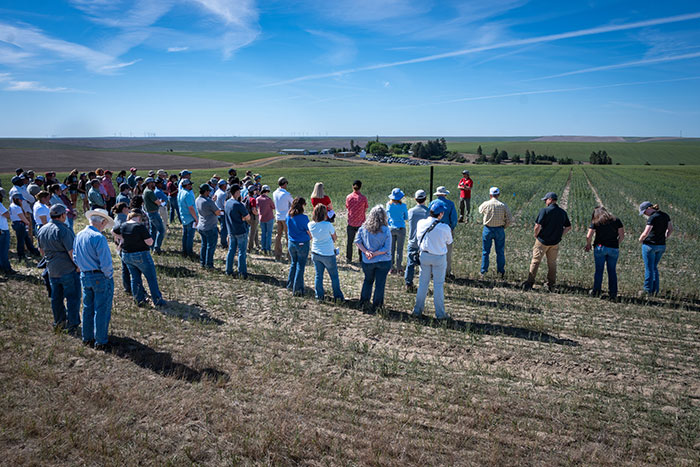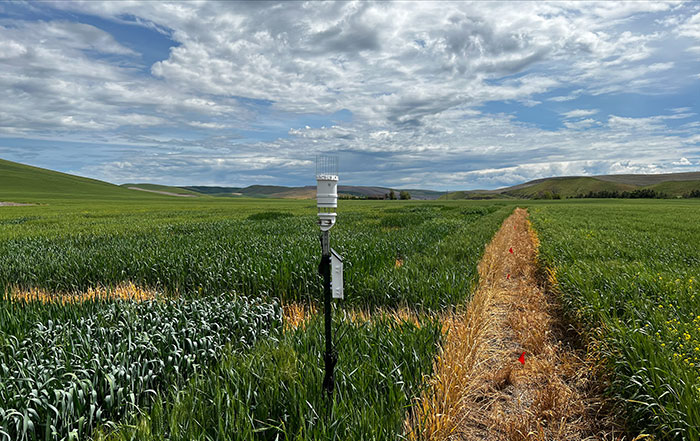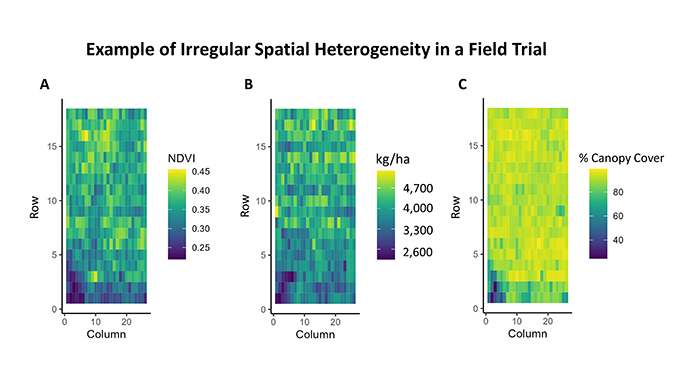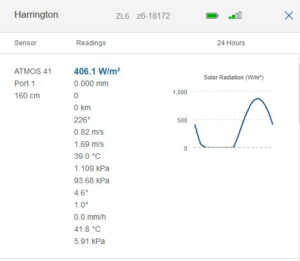Measuring phenotype by genotype by environment interactions

By Arron Carter
For almost all plant breeders, the interaction of the phenotype, genotype, and environment is crucial to developing new varieties. The phenotype is the trait that is being measured and is determined by the genotype (genetics) of the variety, along with the environment it is grown in. For example, if the phenotype we are looking at is plant height, it will be determined in part by the genetics, whether or not the variety contains zero, one, or two dwarfing genes. The final plant height is also determined by the environment it is grown in. If there is one dwarfing gene in the variety it will be of medium height, but if grown under irrigation, it may be 40 inches tall, whereas if it is grown in rain-fed conditions of only 12 inches of rain, the variety may only be 32 inches.
While we can measure a lot of the phenotypic traits of a variety, understanding the genetics is also very important. Past articles I have written have helped explain the advances we have been able to take advantage of in wheat with regards to the genotype. We have more DNA markers tracking genes of interest, and we have sequencing technologies that allow us to make predictions of future performance of lines. One thing that has been missing in the equation is a better understanding of the environment.
Plant breeders generally characterize the locations that their trials are grown in. You will often hear us saying that we have trials in “low rainfall locations” or “high rainfall locations.” Other times you will hear us say that it was a “cool wet spring” or a location was affected by “terminal drought.” We generally characterize these locations to help us better understand the traits we are measuring such as plant height, heading date, test weight, and grain yield. As we get a better understanding of both phenotype and genotype, it is becoming more important for us to better understand the environment. Understanding the environment will help better understand the trait we are measuring.

If we are looking at grain yield in a “high rainfall location,” it will be important to know when the rain actually came. Did most of the moisture come in the form of snow melt? How much did it rain in April and May? Were there any late June rains that helped the crop finish strong? All of these are important questions to have answered if we want to fully understand grain yield as a trait and the genetics that are controlling the performance of that line in that specific environment.
In addition to this, when our breeding lines are tested the first year in yield trials, they are unreplicated and usually only tested in two or three locations. When lines are selected to be high yielding, they are only high yielding based on the environment they were grown in. I have written previously how our drone sensor technology is helping us better understand how the plants are interacting with the given environment, and how the sensor data is helping select better cultivars in given environments, but we are still missing the fine details of the environment.
To that end, we partnered with Meter Group Inc. to acquire six ATMOS weather stations to be placed at each breeding location (Figure 1). These are the same weather stations that are used by AgWeatherNet, so between the six units the breeding program has and other breeding locations that are adjacent to AgWeatherNet stations, all our breeding locations now have active weather monitoring. We installed these stations in 2022 and are now collecting our third year of data.
With this data, we are beginning to understand how the environment is interacting with each genotype we are testing. Using a combination of drone sensor and environmental data, we can adjust the performance of breeding lines tested in large trials. Previously, lines would be replicated across the field and adjusted based on their performance in each replicate. With large trials, replication is difficult, leading to unreplicated trials that are affected more by field variations (Figure 2). Adjusting performance of breeding lines in unreplicated trials with sensor and environmental data has improved trial data as if it had been adjusted based on replication. This allows us to grow more lines in individual locations each year, but still get robust data that a replicated trial would have provided.

While this is just a first step in how to use the data, we are excited to continue to use environmental data to better understand breeding lines and their performance. Knowing the exact environmental parameters of each location, such as when it rained, how much it rained, how much evapotranspiration was happening (which is a measure that combines water evaporation from the soil and water transpiration from the plants), what the temperature was, and the myriad of other data we can collect, will help understand what made a breeding line so good (Figure 3). As we continue to collect data over varying environmental conditions, we can begin to build models to start asking questions about how breeding lines will perform in very specific weather conditions.

Understanding the environment is going to be a key part of breeding in the future. As our climate continues to vary across Washington and from year to year, having cultivars that can be resilient to those changes will be important. Being able to incorporate environmental data into selection and decision making will hopefully allow us to develop better cultivars. I use the word hopeful because we are just starting to use this data within the breeding program. The coming years of selection and testing will be the true test as we watch how different breeding lines perform after selection. While I am cautiously optimistic, I am still very excited about using this technology to improve cultivars for the state of Washington!
This article originally appeared in the August/September 2024 issue of Wheat Life Magazine.

Arron Carter, Ph.D.
Arron Carter, Ph.D., holds the O.A. Vogel Endowed Chair of Wheat Breeding and Genetics at Washington State University. His research is directed toward breeding improved wheat varieties for cropping systems in Washington state that incorporate diverse rotations and environments. His research goal is to release high-yielding, disease resistant varieties with good end-use quality that will maintain profitability and reduce the risk to growers. New varieties are developed using a combination of traditional plant breeding methods, molecular marker technology, and biotechnology. Read more about Dr. Carter.
